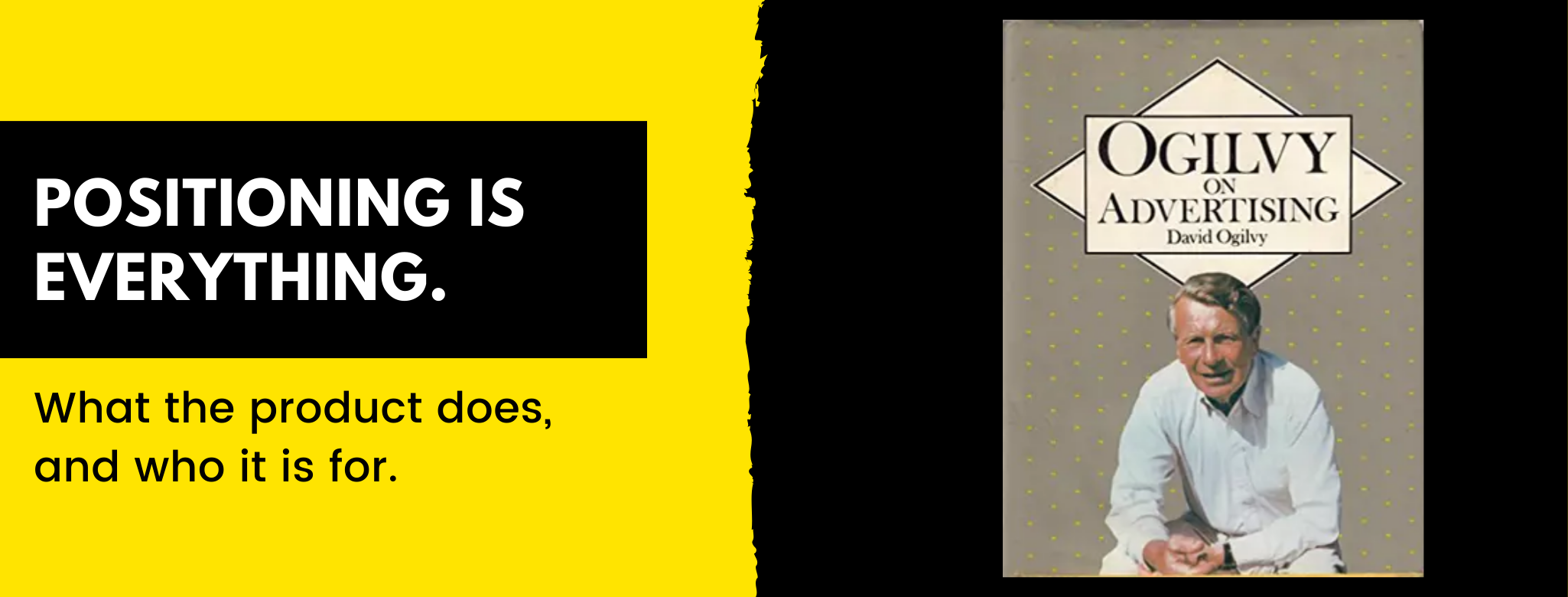How to craft a strong product positioning statement (with just one sentence).
Product positioning is what your product or service does and who it is for. It influences everything from pricing to targeting and even ad creatives. Here’s how you do it easily and effectively.

David Ogilvy’s Ogilvy On Advertising is always on my desk. Never more than an arm’s length away. It’s like a bible to me (Ogilvy would have hated that).
On page 12, Ogilvy talks about positioning.
“Now consider how you want to ‘position’ your product. This curious verb is in great favor among marketing experts, but no two of them agree what it means. My own definition is ‘what the product does, and who it is for.’ I could have positioned Dove as a detergent bar for men with dirty hands, but chose instead to position it as a toilet bar for women with dry skin. This is still working 25 years later.”
—David Ogilvy, Ogilvy on Advertising.
It seems that many marketers today mistake themselves for advertisers. They skip past any research and strategy to plunge right into the Facebook Ads Manager or whatever platform is hyped right now.
A failing campaign gets attributed to bad ad creatives or not enough testing. But the problems begin much earlier.
What is product positioning?
Ask ten different marketers what product positioning is, and you’ll get ten different answers. I keep it simple and follow David Ogilvy’s true and tested definition of product positioning:
Product positioning is what your product or service does and who it is for.
Why is product positioning so important?
You haven’t done any positioning for the product you’re advertising? It’s high time you start.
Positioning matters so much because it influences everything from pricing to targeting and even ad creatives. How you position a product is the very base of its prowess on the market.
To take the example from Dove, imagine Ogilvy would have positioned Dove as a soap for handymen. It would have been one of many soaps that no hard-assed ‘50s man would have cared about. The lower the price, the more likely the sale would have been.
But positioned as a toilet bar for women with dry skin, it became a product of luxury. The Dove soap bar sold at twice the price of the company's existing Lux soap and established Dove as a core household brand.
I position myself as a boutique copywriter for brands who love themselves. That positioning lands me clients that are happy to pay my rates and appreciate the results instead of content mills that pay $0.05 per word and don’t give a fuck.
How to successfully position any product .
Marketers today love to jump right in, and clients want quick results. Research is boring and doesn’t bring in sales. Many don’t bother.
If you don’t do your homework, you’re shooting from the hip when you could use a 12x scope.
Although you may luck into a successful campaign occasionally, there is no great campaign without proper research.
Study the product or service.
Since this morning, I’m wearing a pair of fake magnetic eyelashes.
I ordered the lashes through my client’s website, waited for the package, unboxed it, watched the tutorials, and put the lashes on. I experienced it as a customer—and documented it.
I read everything I could get my hands on about these lashes, from material spec sheets to Reddit forums about makeup.
The more you know about the product or service you’re going to advertise, the more likely you will be to succeed.
Study the competition.
You don’t want to accidentally position your product in the exact same way your competition does. But they might be a good source of inspiration.
Find out who your competitors are, what they promise (their solution), and who they promise it to (their customer).
Study the customers.
It happened to me before. I thought I was advertising the perfect solution to a problem countless people were suffering from. Turns out almost nobody besides me had that problem.
Marketers and business owners tend to get caught up in their own brands. We think what we do is great, and everyone will love us for it.
We are not our customers. How we see ourselves is rarely how our customers see us. It’s like parents thinking their kid looks like Brad Pitt when it looks like Sloth Fratelli.
Be humble. Let go of what you think about the brand.
Find out what your customers think about your product or service and what promise would most likely get them to buy.
Standardized surveys you send out to your email list work well, but the best thing you can do is have an informal conversation over a drink with someone who resembles your ideal customer.
Positioning made easy: Fill in the blanks.
Doing the homework is the hard part. Once that’s done, the positioning should come fairly easy.
For most brands, it’s enough to answer what the product does and who it is for.
To craft a more extensive positioning statement, use this simple fill-in-the-blanks sentence by Geoffrey Moore.
For (target customer) who (statement of the need or opportunity), the (product name) is a (product category) that (statement of key benefit – that is, compelling reason to buy). Unlike (primary competitive alternative), our product (statement of primary differentiation).
That’s how the extensive positioning could have looked for Dove:
For women with dry skin who suffer from inflammation and eczema, the Dove is a toilet bar that creams your skin while you bathe. Unlike old-fashioned soap, our product leaves your skin soft and smooth without the dry feeling.
Your positioning can even serve as inspiration for your ads.
That’s it. I’m out.
—Pat